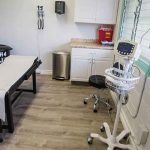Hawaii’s growing homeless problem has prompted the state’s largest health care companies to join forces with the city to provide medical services, respite and housing to some of Oahu’s most needy residents.
A group composed mostly of private-sector leaders, including Hawaii Medical Service Association and The Queen’s Medical Center, is moving forward with a plan to turn a four-story city building in Iwilei into an epicenter for homeless services that will include a 24-hour urgent care center with primary and mental health services; a rapid detox and wound care center; and a place for the most critical patients to stay for up to 30 days while being treated for chronic diseases, mental illness and other serious health conditions.
“Homelessness is a humanitarian crisis and a health economic crisis,” said state Sen. Josh Green (D, Naalehu-Kailua-Kona), a Hawaii island emergency room physician, who is heading the project. “Homeless individuals live to an average age of 51, three decades shorter than average in Hawaii, so it’s objectively a health condition. The surge in chronic homelessness and its crushing impact on our best hospitals on Oahu … make it a statewide public health and economic emergency that has to be addressed. These hospitals’ survival depends on action.”
| HOMELESS HEALTH CARE CENTER
The city plans to turn this four-story industrial building at 431 Kuwili St. in Iwilei into the first all-in-one space to help the homeless. >> Floor 1: City and County Hygiene Center >> Floor 2: Health Floor, Crisis Health and Complex Urgent Care (teams from medical providers) >> Floor 3: 21 units for housing for those who require complex medical care, and hospital discharges >> Floor 4: 21 units reserved for longer-term homeless with complex medical and behavioral health needs pending longer-term placement HOMELESS HEALTH ECONOMIC CRISIS >> The average spent per high-utilizer patient is $92,000 per year. >> About $1.2 billion of the state’s annual Medicaid spending goes to just 3.61 percent (13,000 people) of Hawaii’s beneficiaries, including chronically homeless people. >> The Queen’s Medical Center provides an estimated $10.5 million per year in uncompensated care to the chronic homeless community. >> The H4 program has the potential to save $30 million to $50 million in health costs per year statewide. |
In 2016, state hospitals billed $214 million — or $29,862 per patient — in charges for caring for the homeless, compared with $70.5 million in 2010, according to the Hawaii Health Information Corp., a nonprofit health data company. There were 20,323 homeless hospital visits statewide last year versus 11,619 in 2010.
“I see the ambulance down here more than I see the people that live around here,” Loren Hammond, a homeless man who lives at Aala Park, said Friday while being treated by a community health nurse for multiple leg wounds. “If I feel I need them, I’ll call them. It works out for the homeless people. A lot of these guys don’t have insurance. If you got insurance, (they’ll) take care of you. If you don’t have insurance, you got the shortest stay in history: ‘We’re going to bandage you up and put you back on the streets.’”
The project, known as “H4” — hygiene, health, housing and humanitarian — targets the highest users of services at Hawaii’s hospitals in hopes of diverting them to more appropriate and less expensive treatment. The group plans to raise $5 million from the private sector to open the facility in 2018.
“It’s almost like we’re reaching down to the hardest, most challenging patients who are suffering the most,” said Dr. Scott Miscovich, who designed the project. “The problem is that … the majority of homeless that are unsheltered in our state are not only socially homeless, they’re also being crushed by severe complex conditions. You can’t fix those with social services.”
Miscovich and Green, chairman of the Senate Human Services Committee, argue that the state is not doing enough to address the health aspect of homelessness.
“(State Homeless Coordinator Scott) Morishige and the governor’s team has failed to acknowledge this, and until programs like H4 get launched, the statewide health care safety net and the Medicaid budget will be gravely threatened,” Green said.
The state so far is “just not making any progress” in its efforts to solve homelessness and stem the bleeding among the private medical community, Miscovich added.
“They’re affecting tourism, our local residents, our neighborhoods,” he said. “More importantly, these people are suffering. These people are dying in the streets.”
The state has focused its efforts to address homelessness largely on affordable housing, including expanding programs that provide permanent supportive housing for the chronically homeless population.
“The state is supportive of efforts by the City & County of Honolulu and others to bring online new programs that align with this framework and address the needs of the unsheltered homeless population, including individuals with chronic medical needs,” Morishige said in an email.
Unfilled needs
Honolulu Mayor Kirk Caldwell met with health leaders Thursday to discuss the H4 proposal as a way to alleviate the significant impacts of homeless health care on hospitals and primary care providers. The city had originally planned to use the proposed location at 431 Kuwili St. to create a hygiene center, as well as space for social services and permanent supportive housing, according to the mayor’s spokesman, Jesse Broder Van Dyke.
“In concept, Mayor Caldwell is supportive of the proposal and looks forward to receiving this operational commitment from the private health care providers because it would certainly be a game changer on how we deal with the high cost of homeless health care,” Broder Van Dyke said. “Mayor Caldwell would like to first see a specific operations and management plan and the specific funding commitments before making any change. It’s not a done deal but it’s making progress.”
Queen’s estimates it handles 64 percent of the state’s homeless hospital encounters, mostly through the ER, resulting in unreimbursed costs of about $10.5 million annually. Nearly 80 percent of the 10,100 homeless patients who went to Queen’s in 2015 were diagnosed with behavioral or substance abuse issues.
“Our motivation is that there is a need that seems yet to be filled,” said Queen’s President Art Ushijima. “I don’t think there is anything in our community that seems to provide that level of support to the homeless, particularly the substance abuse and behavioral issues that these individuals have. I don’t know if there is this holy grail that solves the homeless issue. I don’t know if we will ever be without homeless, but at the same time at least we can reduce that number.”











